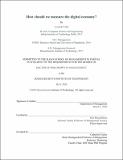How should we measure the digital economy?
Author(s)
Collis, Avinash.
Download1191222397-MIT.pdf (3.806Mb)
Other Contributors
Sloan School of Management.
Advisor
Erik Brynjolfsson.
Terms of use
Metadata
Show full item recordAbstract
Gross domestic product (GDP) measures production and is not meant to measure well-being. While many people nonetheless use GDP as a proxy for well-being, consumer surplus is a better measure of consumer well-being. This is increasingly true in the digital economy where many digital goods have zero price and as a result, the welfare gains from these goods are not reflected in GDP or productivity statistics. Chapter 1 proposes a way of directly measuring consumer's economic well-being using massive online choice experiments. It finds that digital goods generate a large amount of consumer surplus that is currently not captured in GDP. For example, the median Facebook user needed a compensation of around $48 to give it up for a month. Building up on these results, Chapter 2 extends the GDP framework to include welfare gains from new and free goods and construct a new metric called GDP-B, where B stands for benefits. It finds that including the welfare gains from Facebook would have added between 0.05 and 0.11 percentage points to GDP-B growth per year in the US. Chapter 3 proposes a way of measuring network effects on multi-sided platforms using choice experiments. It also models digital platforms allowing for heterogeneity in demand elasticity and network effects across users of different types. It then calibrates the model using an empirical application to Facebook and simulates six different taxation and regulatory policies. Chapter 4 looks at the impact of social media on subjective well-being and academic performance through a randomized controlled trial of University students. Chapter 5 summarizes the research agenda moving forward and concludes with a framework for measuring different aspects of well-being in the digital economy.
Description
Thesis: Ph. D., Massachusetts Institute of Technology, Sloan School of Management, June, 2020 Cataloged from PDF version of thesis. Includes bibliographical references.
Date issued
2020Department
Sloan School of ManagementPublisher
Massachusetts Institute of Technology
Keywords
Sloan School of Management.